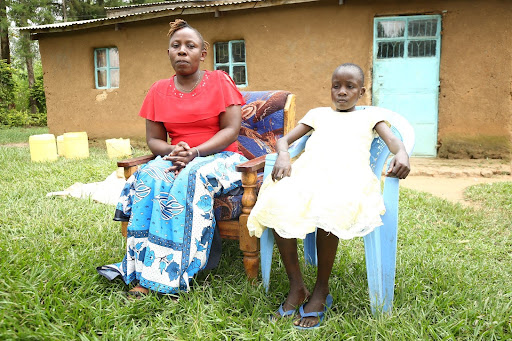
By Thomas Mwiraria
Bungoma County, Kenya: Michelle incessantly cried day and night. She seemed to be in severe pain. She was only a month old when her mother noticed the crying was unusual. At this point, Rachel Nziwa Simiyu decided to take her daughter Michelle Simiyu Nekesa to Bungoma Children’s Clinic for examination.
For five years Rachel camped at the Clinic, the child was overly weak. Children tend to cry less as they get older but with baby Michelle, over-the-top reactions did not stop, she was anemic. She was regularly on blood transfusions due to recurrent anemia.
In April 2016 when the girl was 5, the doctors at Bungoma Hospital referred her to Kenyatta National Hospital, Ward 3D.
She was admitted for a month to Kenyatta National Hospital and the consultant Dr. Okello took a sample of her bone marrow for investigation. The Doctor did UEC’s, IFBC, PBF+Retic Count, LDH, and CXR investigations.
The child was discharged from the National hospital and a month later in May 2016, she was diagnosed with a rare and chronic blood disorder called Pure Red Cell Aplasia (PRCA).
Dr. Dickens Lubanga, (CMBCHB; M-MED (M. Med Pediatric and Child Health) Pediatrician- Bungoma Children’s Clinic, explains the body has three cell types: Red Cells, White Cells, and Platelets. When the three cells are affected it is called Leukemia, and only when the Red Cells are affected the disorder is called Pure Red Cell Aplasia.
Pure Red Cell Aplasia happens when bone marrow doesn’t produce the normal number of red blood cells and causes anemia.
According to the National Library of Medicine Pure Red cell aplasia (PRCA) is a syndrome defined by a normocytic normochromic anemia with severe reticulocytopenia and marked by a reduction or absence of erythroid precursors from the bone marrow. Diamond-Blackfan anemia is a congenital form of PRCA.
Often exhibiting paleness, general body weakness, dizziness, and sometimes lethargy, her mother brings her to the Children’s clinic every two weeks for a blood transfusion. For 12 years now, Rachel Nziwa Simiyu has made a daunting 13 km journey in rough terrain from Lutungu Village in Kanduyi Constituency to Bungoma Children’s’ Clinic.
“We transfuse the child’s blood every month. It is more of supportive care” Dr. Lubanga points out. And adds that the regular transfusion causes a number of side effects mainly infections, and antibiotics may take a toll on patients.
“As part of transfusion, we put the patient on chemoprophylaxis because they are prone to infections: Viral, Fungal, Bacterial”he explains.
Chemoprophylaxis means taking medication as a preventive measure to stop getting infections or diseases from close contact. In that, as in the case of Michelle, Antibiotics, are administered to prevent infections (particularly opportunistic infections)
Even so, the transfusion is prone to side effects Prophylactic Antibiotics, that is, the antibiotics meant to prevent infection, Dr. Lubanga explains.
“The level of hemoglobin as in the case of Michelle is low due to regular transfusion.”

As stated in the National Library of Medicine, Hemoglobin (Hb) is the protein contained in red blood cells that is responsible for the delivery of oxygen to the tissues. To ensure adequate tissue oxygenation, a sufficient hemoglobin level must be maintained- National Library of Medicine
In Sub-Saharan Africa, there is no standard treatment for PRCA save for blood transfusion.
‘Sometimes we use anti-cancer drugs to treat PRCA, ‘ Dr. Lubanga explains, adding that anti-cancer drugs work on bone marrow.
Michelle is now 12, a third born in a family of five. Her growth milestones have been delayed due to frequent blood transfusions. She battles on.
Sickle Cell, and PRCA: The Nature and Treatment
Dr. Karau explains sickle cell disease and PRCA are different diseases. And they are not autoimmune in nature. Autoimmune diseases refer to diseases caused by a reaction or misplaced body’s immunity attacking one’s own tissues. For example, lupus and rheumatoid arthritis.
On treatment, the Doctor explains the current treatment for sickle cell disease in Kenya is a drug called hydroxyurea, coupled with supportive treatment. This includes blood transfusions, pain control, and antibiotics when infection strikes. There’s the option of bone marrow transplant but it is not yet available in Kenya.
Gene Therapy Treatment
Dr. Karau says Gene therapy holds great promise for the treatment of both sickle cell disease and PRCA.
“Gene therapy for SCD is usually done for those below 12 years of age in a severe crisis. It involves editing of the culprit Gene so that the hemoglobin produced is normal type” says Dr. Karau.
He reveals that a gene therapy called Casgevy is pharmaceutically approved for sickle cell disease, but it will take years before it is available and affordable in the global South.
Announcing the two approved milestone treatments; Casgevy and Lyfgenia, The U.S. Food and Drug Administration (FDA) in the 8th December 2023 Press release said the therapies represent “the first cell-based gene therapies for the treatment of sickle cell disease (SCD) in patients 12 years and older. Additionally, one of these therapies, Casgevy, is the first FDA-approved treatment to utilize a type of novel genome editing technology, signaling an innovative advancement in the field of gene therapy”
Victoria Gray’s Sickle Cell Gene Editing Story
Victoria Gray, a 38-year-old mom of four from the US is the first person in history to undergo a revolutionary gene editing technique called CRISPR after three decades of painful battle with Sickle Cell Disease.
Dr. Emmanuelle Charpentier, and her collaborator Dr. Jennifer Doudna, co-invented CRISPR/Cas9 gene editing. The duo won a Nobel Prize for this groundbreaking work which has revolutionized biomedical research and enabled medical breakthroughs.
CRISPR/Cas9 edits genes by precisely cutting DNA and then harnessing natural DNA repair processes to modify the gene in the desired manner. The system has two components: the Cas9 enzyme and a guide RNA. This is according to the CRISPR Therapeutics Journal.
CRISPR/Cas9 – a revolutionary gene-editing technology that can be used to modify or correct precise regions of our DNA to treat serious diseases
The future of Treatment of PRCA
Dr. Karau says “The treatment of PRCA depends on the cause. For congenital PRCA, or PRCA caused by spontaneous mutations, stem cell transplant is the treatment of choice. Gene therapy for PRCA is at the experimental stage and may take long to come through. Remember that PRCA is a widely heterogeneous disease, which can be caused by viral infections, autoimmune conditions like lupus, and even drugs. So, treatment depends on the cause”
He goes on to say Gene therapy holds promise for autoimmune diseases, especially ones that are caused by genetic aberrations. This is a fast-evolving field and in the next decade or so, could provide a cure for otherwise incurable diseases.
“Some diseases like type 1 diabetes could also benefit from gene therapy.Gene therapy simply implies two things: gene editing to remove an extra base in a chromosome that codes for a certain gene, or editing to add a missing base pair. It may also imply gene reprogramming to produce genes that perform the function for which a certain gene is missing”
In Global South, he adds that the main problem is money. Studies run into billions and not one African government is ready to budget for such. Most research institutions in the global South have to wait for funding from the USA and Europe.
Immunosuppression/ Immunomodulation
According to the National Library of Medicine, the therapeutic approach to PRCA typically involves immunosuppression, but specific pathogenic subtypes are associated with specific therapeutic approaches. Cyclosporine A, with or without concurrent corticosteroids, appears to be the single most effective immunosuppressive agent.
The journal further says for primary acquired autoimmune PRCA, PRCA with LGL leukemia, PRCA associated with solid tumors, or secondary PRCA refractory to other therapy, the treatment of choice is immunosuppression. In principle, PRCA secondary to autoimmune/collagen vascular disorders may respond to therapy specific to the management of those disorders.
The National Library of Medicine elucidates that in practice, the treatment of these disorders is usually immunosuppression, and in cases where alternative disease-modulating therapy is available, the patient is usually referred to the hematologist because it was ineffective. The goal of treatment is to attain a normal hemoglobin concentration without any requirement for transfusion; a partial response is the attainment of transfusion independence with a low but clinically acceptable hemoglobin concentration.
We looked at the National Library of Medicine (NLM) pooled data from 4 series evaluating immunosuppressive therapy in PRCA. Response of patients with PRCA to immunosuppression as demonstrated in the table below is rather encouraging.
Rare Diseases Community
Nord Rare Diseases database has a record of 1200 rare disorders. A rare disorder is a disease or condition that affects fewer than 200,000 Americans. Cumulatively, there are more than 7,000 rare diseases affecting more than 30 million Americans This is according to Nord.
And “for many of the more than 30 million Americans living with a rare disease, out-of-pocket prescription drug costs create significant financial burdens and hinder access to needed therapies. People living with rare diseases need access to affordable treatments” Nord reported in Rare Quarterly in October 2023
In Kenya the Number of People With Rare Diseases is Unknown
Rare Disorders Kenya (RDK)) is a patient-led organization composed of patients, parents, and caregivers of persons diagnosed with rare diseases in Kenya. The Group aims to bring together different rare conditions and rally enough voices so as to be heard by the different stakeholders in the rare community to improve the quality of life of persons with rare diseases in Kenya.
However, there exists no database of the actual rare disorders in Kenya and the affected population.
The common challenges in Kenya are misdiagnosis and delayed treatment as in the case of Michelle. Delayed diagnosis and treatment can lead to irreversible and severe life-threatening consequences.
High medical costs for management pose a barrier to treatment. Dr. Lubanga adds that it would cost up to $3000 for Michelle’s bone marrow transplant. In the Global South access to Gene editing treatment is a far cry from reality.













